The moment I wandered onto Chris Chmiels’ hilly Integration Acres, I found myself surrounded by goats of all ages, shapes and colors. It’s milking time and they gather at the gate of the milking pen like people waiting for a new computer software game at a big box store. They know there is some bodacious feed just feet away and I’m blocking their access. They bite and butt their heads into me, bleating a frenzied salutation: “Hello human, are you edible?”

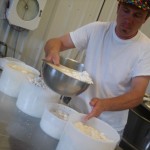
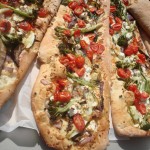
Goats sizing up the interloper, Chris making feta, Pizza al Taglio with goat feta.
Chris Chmiel has invited me here to make goat feta. I’m taking in the whole nine yards, from the milking process to the final aging process. I need some fresh chevre to compliment juicy Amish strawberries, fresh rhubarb and basil for an early summer pizza.
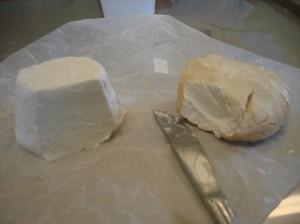
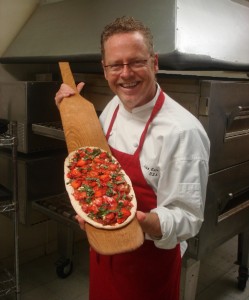
Integration Acres fresh chevre and smoked chevre, chevre and Strawberry Schiacciata.
I use an amazing amount of cheese in my day-to-day operations but none compares to the farmstead chevre and goat feta products in taste, freshness, meltability and topping flexibility. From Turkish pides (Pi-DAYs) to the long Pizza al Taglio (Italian for “peak of the cut”), goat cheese is a must-have ingredient for my pizza repertoire. Both the chevre and goat cheeses are a great foil for sweet fruits and vegetables, offering a creamy-sour bridge from fresh, crunchy vegetables such as broccoli and onion, to salty olives and crunchy crust.
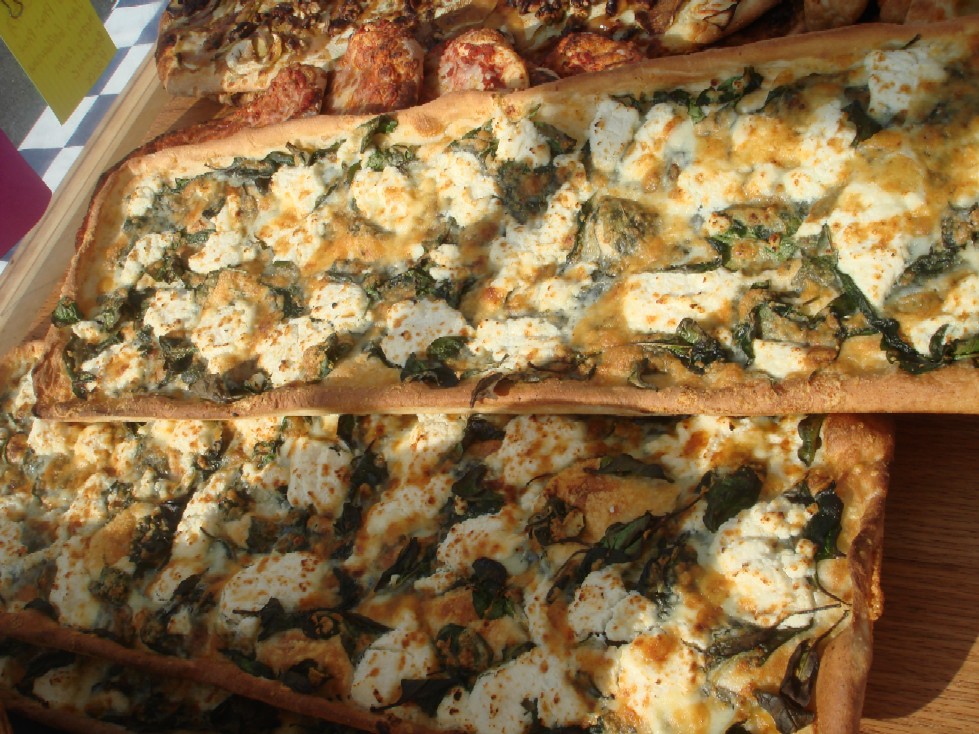
Pizza al Taglio with chevre, apples, fresh spinach, paw paw jam and balsamic vinegar.
Chris Chmiel is one of the few small farmstead producers to make and sell goat cheese in Ohio. Since 1996, he has operated Integration Acres, and his commitment to sustainable agriculture is awe-inspiring. For most guys in the pizza business, as well as most chefs, the closest you get to your cheeses is checking the expiration date on the tub or box. Now I am experiencing and using what is rare: a locally-made cheese from a true food artisan, from udder to table (or in my case, box).
His drive is reflected in his tireless effort to bring the paw-paw back from obscurity. It’s a native Ohio fruit that tastes like banana custard with mango and papaya undertones. I’ve known Chris for the last couple of years, and besides being a die-hard Cubs fan, he is one cool dude. I never knew until now that you have to be mellow to raise goats.
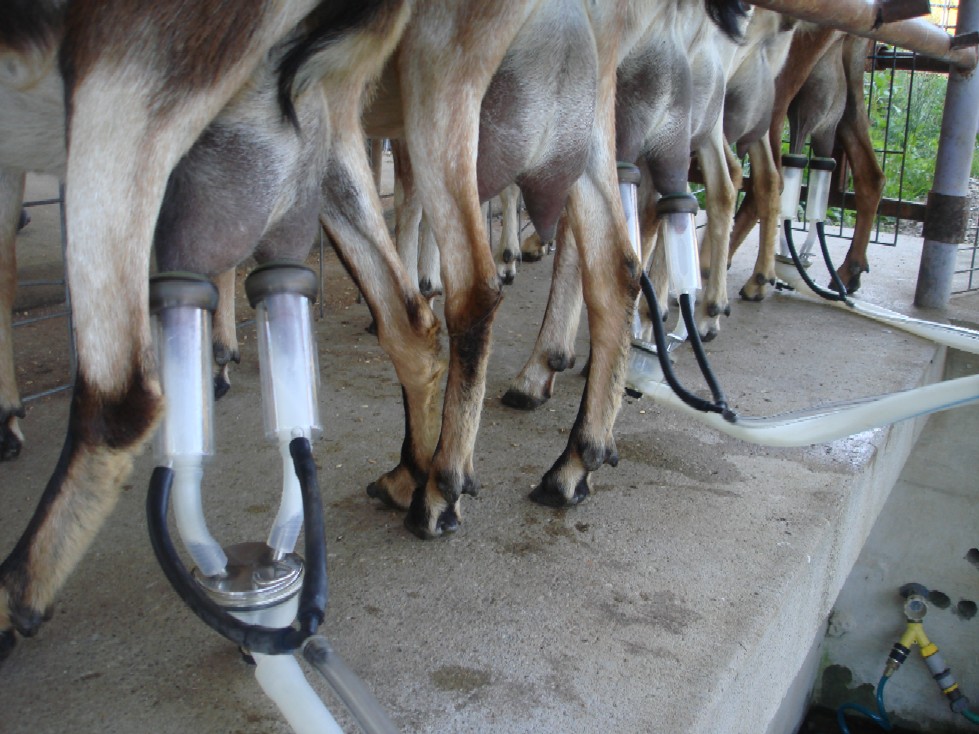
Got Goat? Full udders drained of goat milk destined for goat feta.
“The best way to describe a goat is ‘chaos,’” Chris says, while trying to grab an uncooperative goat’s kicking legs. The goat breaks free and kicks Chris’s arm. “That’s why they’ve got no one to blame but themselves for the bad rap and association with the devil throughout the ages,” he says. It kicks him again, and Chris gives up. The goat runs away.

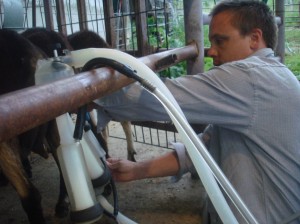

A youngster gets stuck in the fence, Chris milking, another goat wants to get stuck in the fence
Chris starts the milking process by letting the goats into the barn six at a time. The goats run down a chute and scramble for position in the granola trough. The feed reminds me of the muesli I once served to Swiss tourists in my younger waiter days. The goats are trapped by an ingenious head panel that keeps each goat in place while Chris turns on the milker that sucks the milk out of each teat. While a few goats kick and haw, most seem content as the milk gets sucked into large containers in a cooler.
The next batch of goats adheres to a more “Satanic” procedure. An extra goat gets into the pen (my fault) and creates havoc among the chosen six. The kicking and bleating become unbearable as suction cups pop off and Chris scrambles to contain the chaos. It reminds me of what a passenger plane must seem like after landing in a river. In seconds, Chris placates the chosen ones, ejects the interloper, and all is back to normal, meaning only mildly chaotic. The juice of life begins flowing again and I’m fired on the spot.
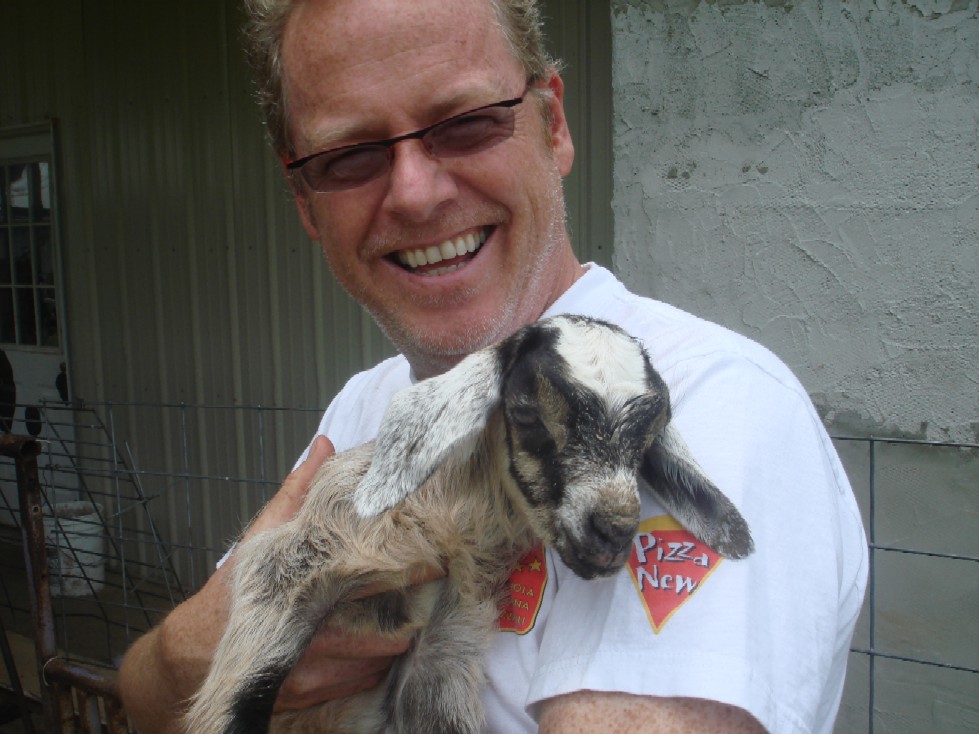
I wonder if Beelzebub was this cute when he was young?
The Chevre
The Integration Acres Chevre has a unique and luxurious creamy tartness with a nutty back-palette taste that only pasture-fed goats can achieve. After years of pizza topping experience with chevre, I’ve learned that there is no way to put it on without using my fingers. I have to flick the sticky curds onto the pizza, and they make silky white islands of lemony-tart flavor. Ironically, just like goats, they present themselves in a random and chaotic pattern.
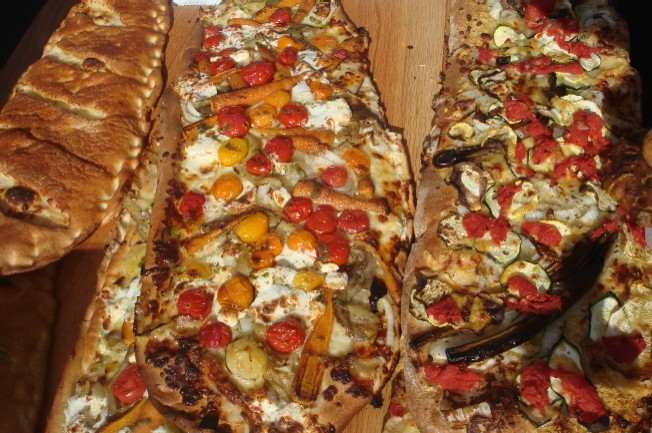
Chevre, ricotta and roasted garlic stuffed fougasse (left). Pizza al taglio with chevre, mozzarella and summer vegetables (center and right).
The Goat Feta
The Integration Acres raw milk feta is aged in a 10 to 20 percent brine solution in a room with a constant temperature between 45 to 50 degrees. It has a texture similar to sheep feta, but with less graininess. It melts better on pizza than sheep feta or the commercial cow’s milk feta, which tends to burn.
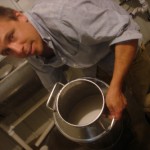

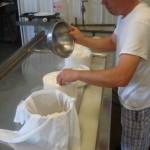
Chris with fresh milk, A goat that had to appear in Star Wars, Straining goat feta.
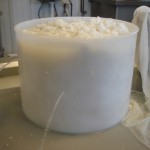
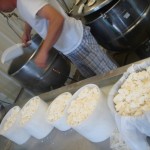
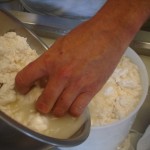
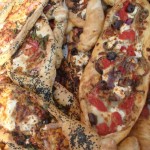
Goat feta draining mold, Filling the molds, My Turkish Pide (Pee-DAY) with goat feta.
When we’re done, Chris offers me a small dice-sized chunk of feta. It explodes in a salty-lemony tang on my tongue. He then transforms the raw goat’s milk by adding a culture to it, waiting an hour then adding diluted rennet and waiting another hour. He cuts the curd and stirs for 20 more minutes, then puts it in a mold to be brined for at least 24 hours.
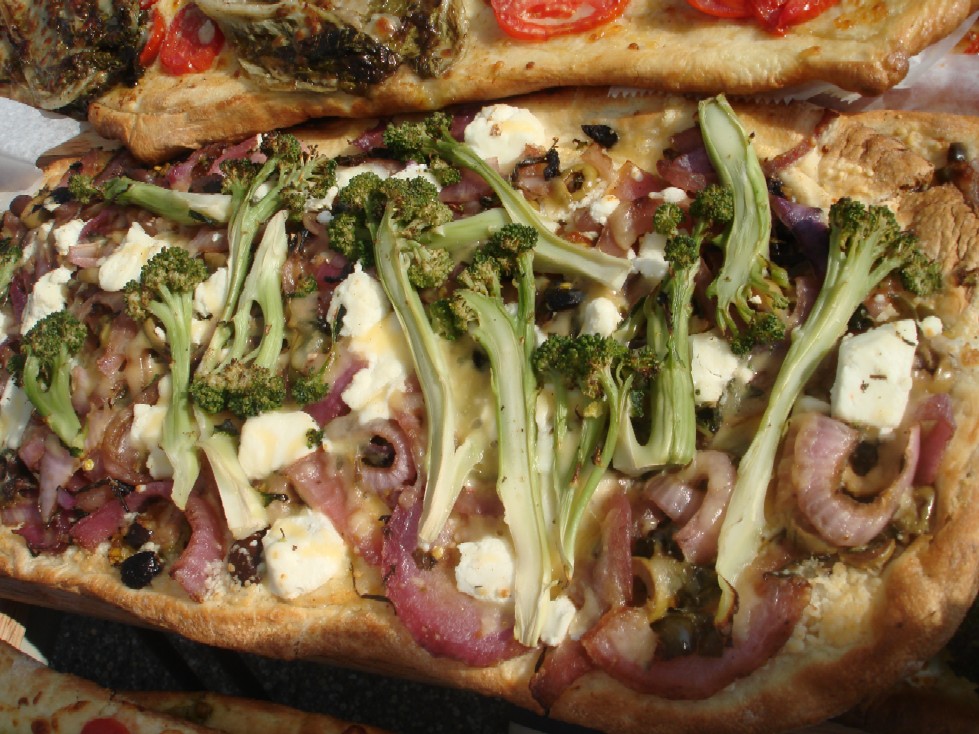
The result: Goat feta with Morrocan oil-cured olives, Sicilian green olives,carmelized red onion, paw paw jam and spring broccoli.
At Avalanche Pizza, I love using goat feta in different combinations including roasted red peppers, apricots, kholrabi, Kalamatas or Morroccan oil-cured olives, black sesame seeds, oven-dried tomato, eggplant and even tahini, grapes, watermelon, and sage. Don’t get me started on broccoli, fennel and even kimchi. Yes, I would recommend the kitchen sink, but porcelain’s flavor profile is more geared toward Gorgonzola.
After my tour at Integration Acres, I can truly appreciate the craftmanship that small cheese producers like Chris Chmiel go through to bring their products to the market. Before I leave, we toast the goats, the milk they bestow upon us, and the ensueing chaos that constantly reminds us we are truly alive.

An udderly fabulous time was had by all, meaning me (left) and Chris.
Strawberry and Chevre Schiaciatta
Americans tend to compartmentalize when it comes to pizza. “Well, is this a dessert pizza or an appetizer?” I get this all the time. Really, pizza can be anything you want it to be. For this pizza, I’ve made a compote of fresh Amish strawberries, Granny Smith apples and rhubarb, then added fresh chevre, almonds, macerated strawberries and basil. It’s agra dolce (sweet and sour) to the max. This pizza would be great in lieu of a cheese course because the tart, sour, creamy, sweet aspect helps you forget all the troubles of the day (or the preceeding dinner.) The crunch of the almonds and the sharp basil zing at the end makes a wonderful compliment to the sweet strawberries.
“Schiacciatta” means “flattened” in Italian. It is flatbread usually found in the Tuscany region, but I’ve enjoyed it in Venice also. Usually the Italians use Tipo 00 flour, a finer milled, higher protein flour than the all purpose flour we use here in the US. Every year at the World Pizza Champioships in Italy I see numerous interpretations of Schiaciatta, some thicker and longer than others. I make them all different ways also. Viva la Difference!
Serves 3 to 8
Easy Dough Recipe
This part is the same as my classic pizza dough recipe. When you strip down all the finesse and personality from a pizza dough recipe, you end up with flour, yeast, salt, and water. I add extra virgin olive oil too because I love the flavor it imparts.
Unbleached flour is best for flavor and vitamins
Just your normal small packets of dry yeast work best. Instant is not as good for longer fermented recipes like this one.
Nothing compliments bread and crust like salt. All-purpose flour requires help with the elasticity of the dough that retains the gasses that form the cells (bubbles for rise) called the “gluten net.” Salt strengthens the process.
Olive oil adds a floral flavor to the dough and helps with manageability and emulsification during mixing. It eases the breakdown of the starches and strengthens the gluten net.
1 1/2 cups unbleached flour and more for kneading
3/4 cup warm/tepid water
1/2 teaspoon crushed sea salt
1/2 teaspoon active dry yeast
1 teaspoon extra virgin olive oil
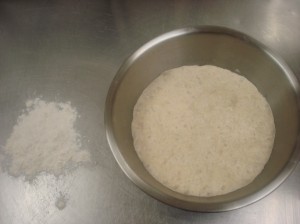
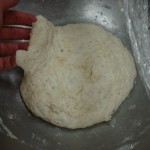
1. This is a 5 hour rise 2. Dough ready for balling
Mix the flour, salt, and yeast together with dry fingers in a large bowl. Add the water and oil and combine until blended. Cover the bowl with plastic wrap set in a 70-80 degree environment for 4-12 hours. This is the primary mixing of the dough. Note: You can let it sit for only 3 hours, but the dough will need a longer secondary proofing for at least 45 to 60 minutes in a 70 to 80 degree environment.
Balling the dough and secondary proofing
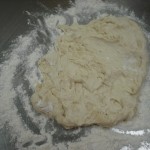

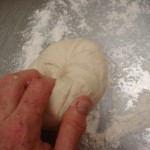
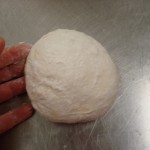
1. The dough 2. Folding the gluten. 3. Making the dough ball. 4. Secondary proof
Sprinkle 1 tablespoon of flour on countertop, then remove the dough from the bowl with a scraper or spatula and place on countertop. Sprinkle flour overthe dough to help with the stickiness.
Take all the dough in both hands and gently knead the outer edges into the bottom to form a ball. Use your fingers to push dough up and into the center of the ball. You are folding the gluten strands into a cohesive round that will make it easier to form a pizza. As you gently push more dough underneath, the top will get firmer. This is a good time to stop. If the ball gets too sticky, roll the ball in flour. Do not over knead.
You should have one 14 ounce dough ball. Place it on an oiled tray and cover with a generous sprinkling of flour and a clean cotton towel, for 15 to 45 minutes.
Forming the Schiacciata
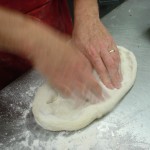
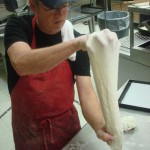
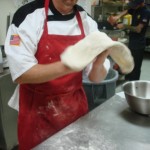
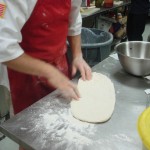
1. Pushing into oval 2. Gravity stretch. 3. Two handed stretch. 4. Rest on countertop.
Take the dough ball in both hands and stretch it into a football shape. Set on a lightly floured countertop and push with fingertips sideways to push gluten strands into shape. Go all the way to the edge with fingertips.
Hold the dough over the countertop. Using the back of your hand, let gravity pull the dough into an elongated form. Make sure the thinner parts don’t rip. Set it down on the countertop and manipulate the dough to even out the thick and thin areas.
With the back of both hands, place with fingers together in the center of the dough. Slowly pull them apart while opening your fingers. This will gently massage and stretch the dough in an elongated form.
Leave the dough on the countertop to rest for 3 to 5 minutes, do not let it sit for longer as it will begin to stick to anything. With this all-purpose flour recipe, there shouldn’t be much “bounceback” (when the round or oval pizza dough contracts back) but there may be some.
Pizza Topping
7 to 9 strawberries
4 tablespoons sugar, divided
1 tablespoon butter
1 cup fresh rhubarb stalks, cut in 1/2- inch pieces
4 Tablespoons apple juice
2 tablespoons honey
Granny Smith apple, peeled and cut in 1/2-inch cubes
1/4 cup slivered almonds, preferably raw so they don’t burn in the oven
3 to 5 ounces fresh chevre
4 to 6 large leaves of fresh basil
Preheat the oven and pizza stone or tray to 425 degrees. You may need to use an upturned cookie sheet if your pizza stone is too small for the sciacciata.
Cut the tops off of the strawberries, turn cut side down and slice through, creating thin slices that will still hold up to a toss in sugar. Put them in a bowl with 2 tablespoons of sugar and toss with a spoon. Return to the strawberries while cooking and continue to toss to make the sweet juices leach from the flesh.
To make compote, heat butter in large saute pan over medium heat. When melted, add rhubarb, apple juice, honey and sugar. Lower heat to simmer, cover, and cook for 6 to 10 minutes, stirring occasionally. Add apple cubes and stir in with the now wilted rhubarb. Simmer 5 to 10 more minutes. Let cool. Taste for sweetness. (Rhubarb can exhibit variations both in tartness and in cooking times. The tender stems in the springtime cook faster and are not as tart as summer rhubarb. Add extra honey or sugar if you like, but remember, there will be juicy, sweet strawberries on the pizza also.)
Put the stretched dough onto a floured pizza peel or parchment that you can slide onto your pizza stone or upturned pan that has been pre-heating in the oven.
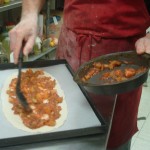
Using a spoon, distribute the cooled compote onto the stretched dough.
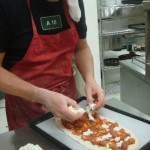
Place chevre on top of the compote.
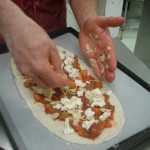
Add the slivered almonds. Now you are ready for the oven.
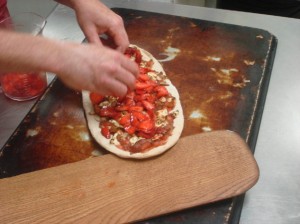
Cook the pizza for 12 to 15 minutes, depending upon the doneness of the dough, the heat radiating from the stone or tray and your individual oven. Look for a golden brown crust and light to medium brown on the bottom of the crust. You may also have to turn the schiacciata to accommodate your oven’s cooking characterstics.
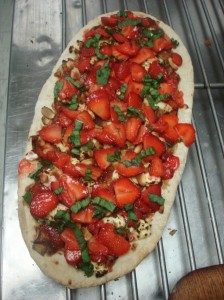
Roll the fresh basil leaves up into a tight ball and slice finely into little strips. Cut crossways against this slice for smaller pieces. Serve immediately.

